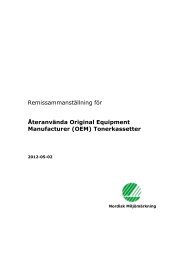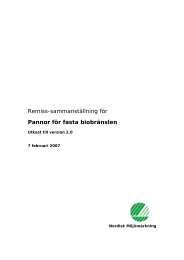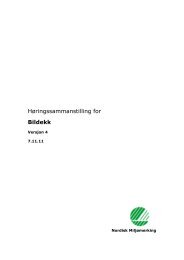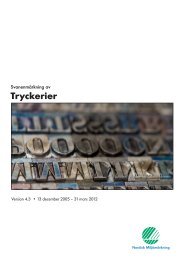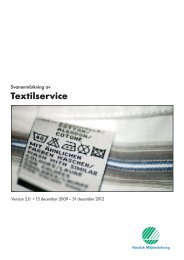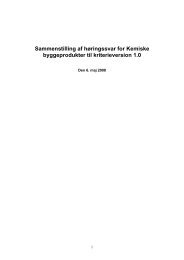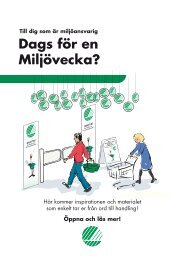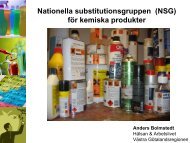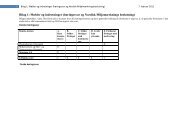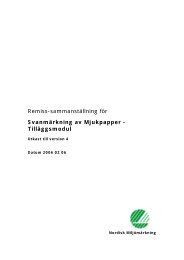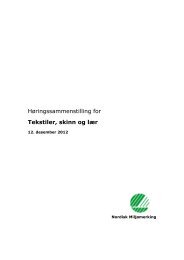Småhus, flerbostadshus och förskolebyggnader - Svanen
Småhus, flerbostadshus och förskolebyggnader - Svanen
Småhus, flerbostadshus och förskolebyggnader - Svanen
You also want an ePaper? Increase the reach of your titles
YUMPU automatically turns print PDFs into web optimized ePapers that Google loves.
Nordisk Miljømerking<br />
Hus, leiligheter og barnehager 089/versjon 2<br />
Høringssammenstilling, oppdatert 10. august 2010<br />
2008. This strategy does not include any restrictions on the use of any zinc products,<br />
including cladding and roofing. Instead, the strategy recognises that the observed elevated<br />
levels in some locations in Europe are derived from point sources from industrial<br />
installations, historical contamination and high background concentrations of geogenic<br />
origin.<br />
Indeed, releases from corrosion of zinc products during service life were carefully<br />
assessed within the risk assessment process and no risks were associated to the use of<br />
zinc in building applications. This included detailed evaluations of releases under current<br />
atmospheric corrosivity and the fate of these releases. Notably, much of the information<br />
on this aspect has been generated by the Royal Institute of Technology’s Department of<br />
Corrosion Science in Stockholm. Moreover, zinc emissions to surface waters have<br />
actually decreased drastically within past decades due to:<br />
(1) the introduction of industrial on-site treatment plants;<br />
(2) the introduction of municipal waste water treatment plants;<br />
(3) better optimization of fertilizer usage<br />
Zinc is a natural and essential element. It is present in water, air, soil and sediments and<br />
may come from various sources – anthropogenic and natural. For example, a recent study<br />
has investigated the different sources contributing to elevated zinc levels in the Ruhr river<br />
basin, in Germany (Hüffmeyer et al. 2009). Results have shown that the most<br />
contributing sources of zinc were coming from geogenic inputs (historical mining activity<br />
together with elevated natural background concentrations). Indeed, the most<br />
significant zinc emissions contributing to elevated zinc levels in water, as identified in<br />
Risk Reduction Strategy are coming from point sources from industrial installations,<br />
historical contamination from old industrialised areas, and high natural background<br />
concentrations due to local geology.<br />
There are many beneficial effects of using zinc in cladding and/or roofing. One of the<br />
most important factors to be considered is probably zinc recyclability. Indeed, zinc is<br />
100% recyclable and 95% of old rolled zinc is effectively recovered and reused in<br />
different applications. The success of rolled zinc recycling is due to a very well structured<br />
market and the high scrap value. The main users for rolled zinc scraps are secondary zinc<br />
refiners, brass and oxide producers. Another important factor is zinc's life cycle<br />
performance, which is measured relative to contributions to current worldwide priorities<br />
like climate change, energy demand, and the consumption of natural resources. When<br />
measured throughout the life cycle of zinc products, the global environmental<br />
performance of zinc against these priorities has been demonstrated to be very good. Zinc<br />
building products such as roofs and cladding can last for generations, and after their<br />
useful life they can be recovered and re-used over and over again.<br />
Among the requirements for the Nordic Ecolabelling, chemical building products must<br />
not be classified. Zinc metal is not classified for any of the endpoints mentioned under<br />
#O15 of the Nordic Ecolabelling document. Indeed, the release rate of zinc ions from<br />
massive form is too small to warrant classification for human health or for the<br />
environment. Therefore, according to this criterion, there is no reason to<br />
113 (165)



